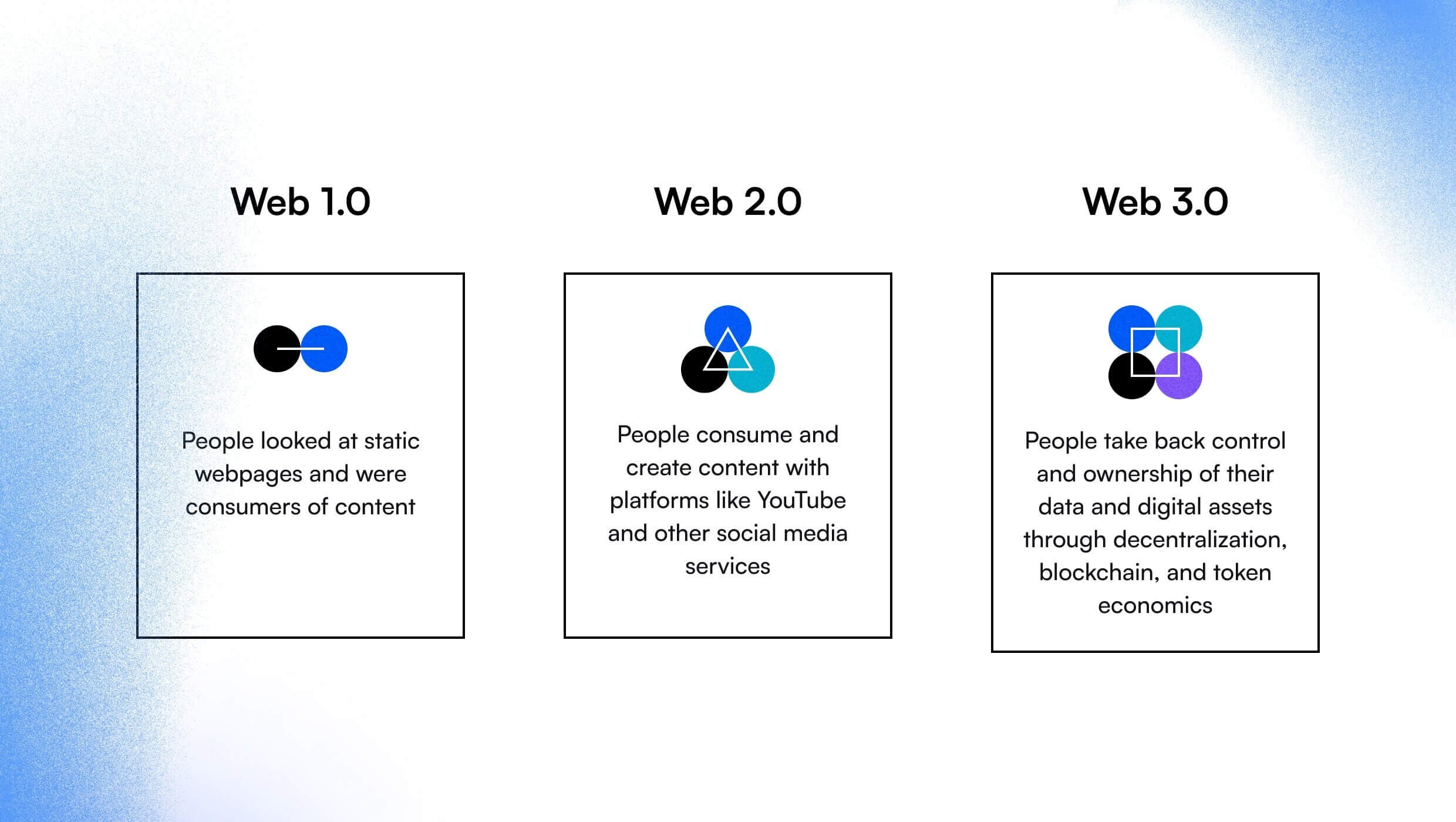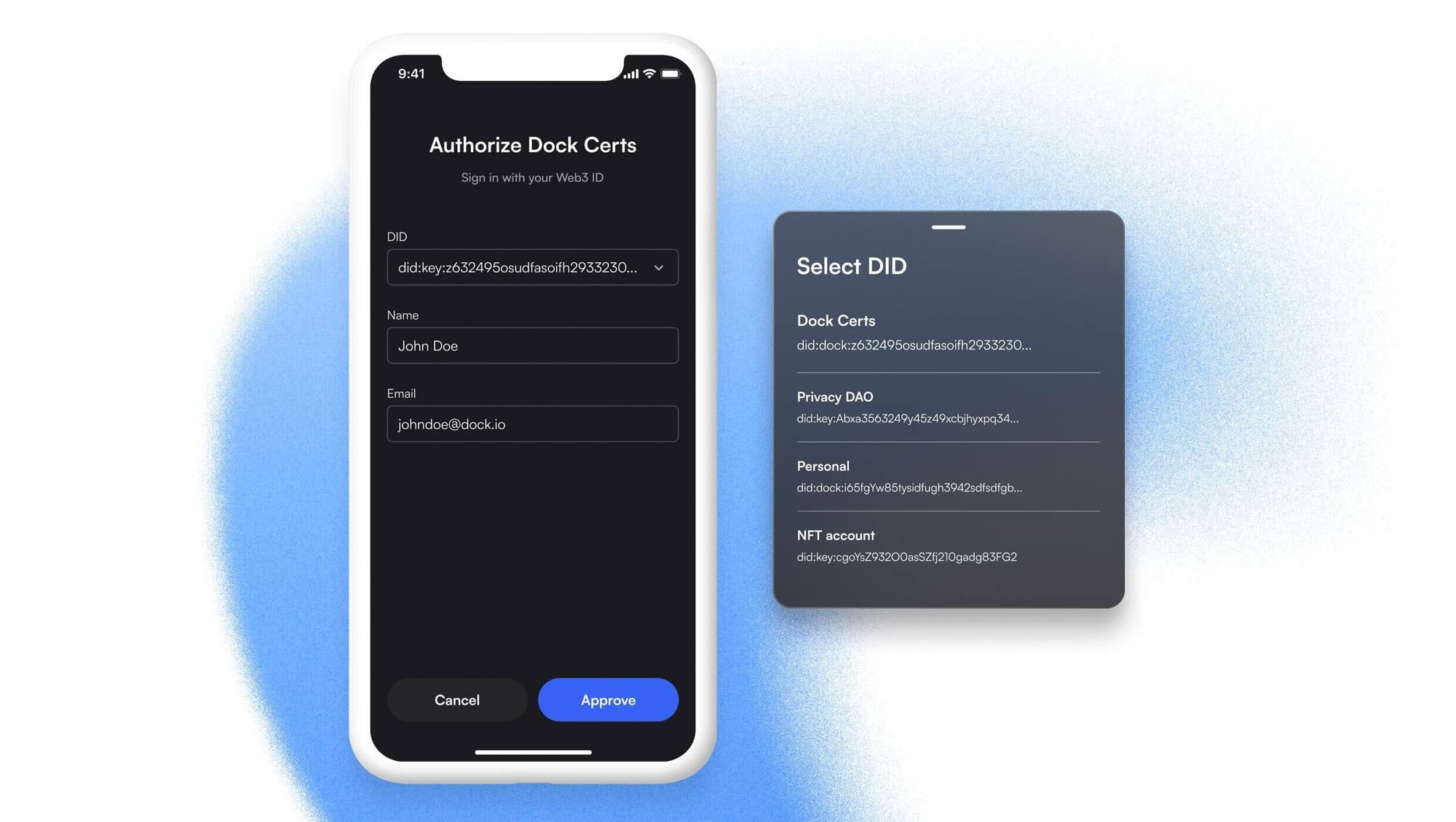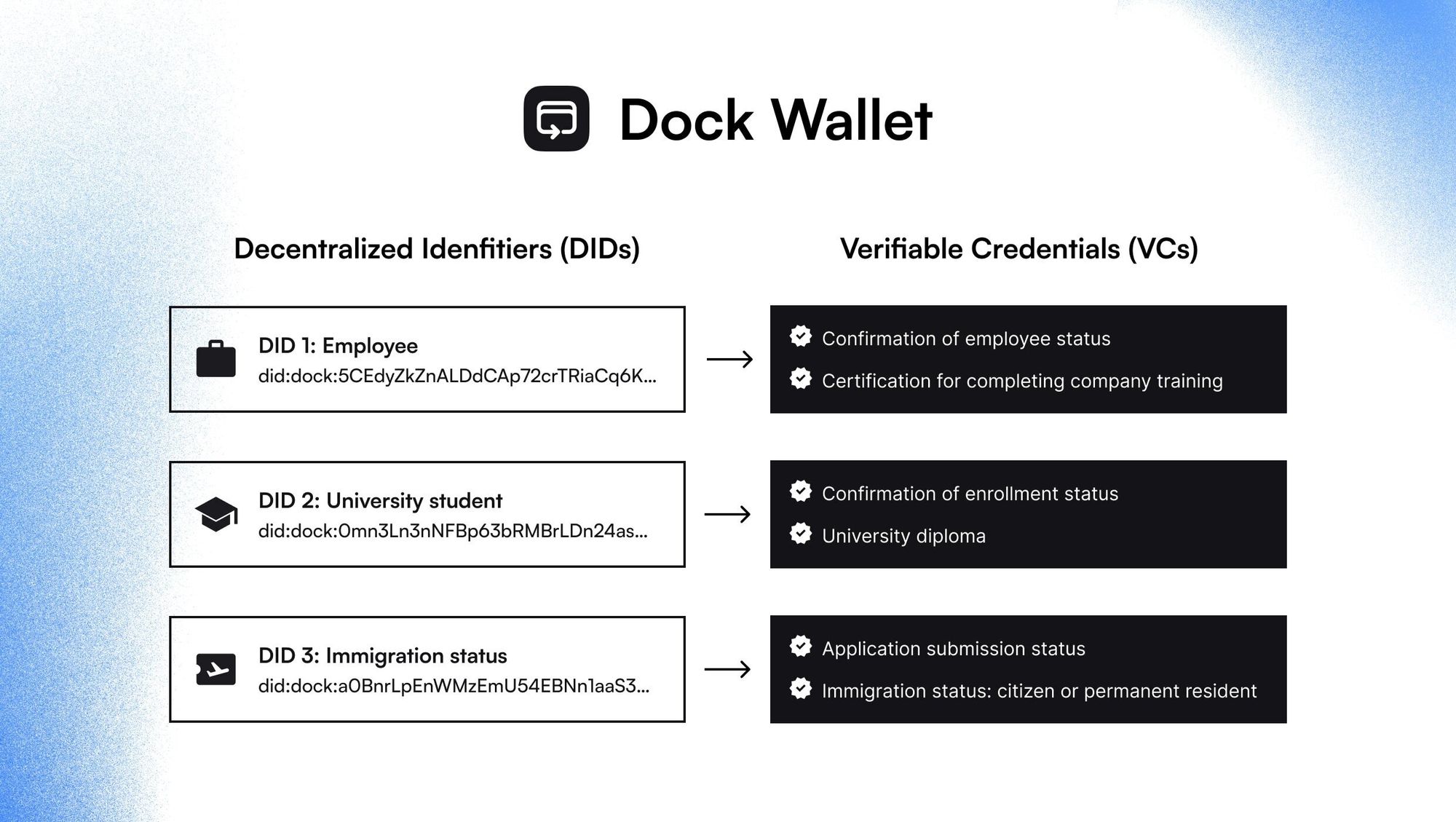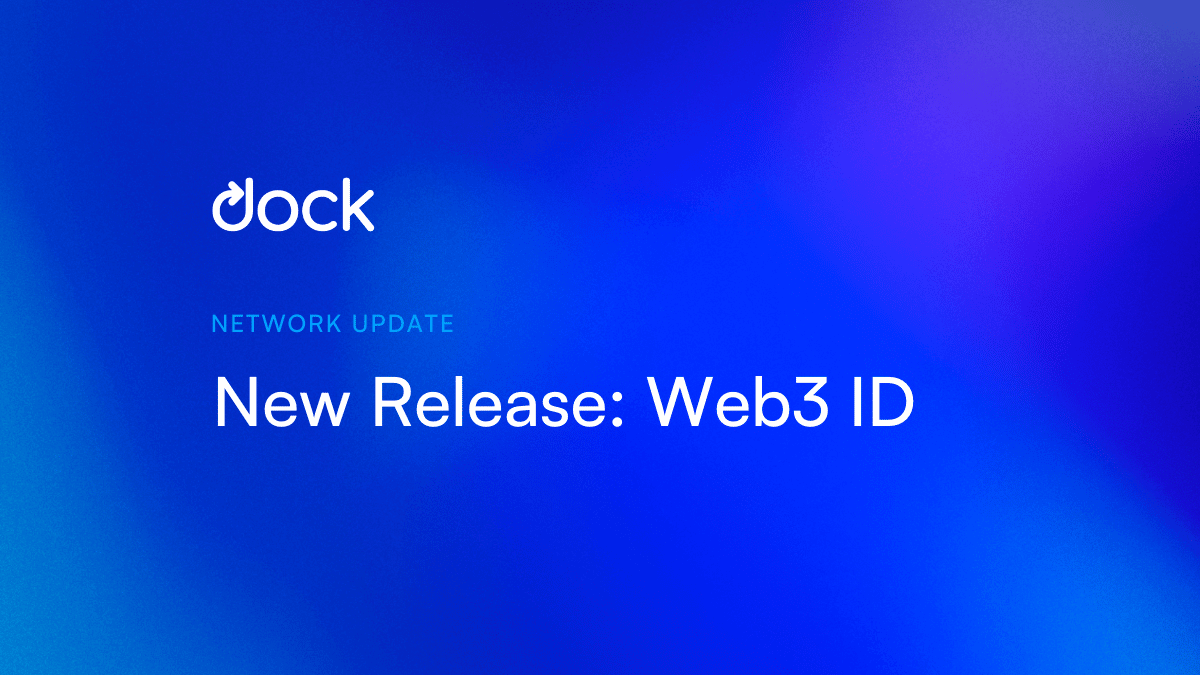TL;DR
- Dock launches Web3 ID, a blockchain-based authentication and authorization system that puts user privacy first
- Organizations can request private user data in a privacy-preserving way that users can trust based on the principles of Self-Sovereign Identity while leveraging the security of cryptography
- Developers can build user-centric apps that eliminate the need for passwords and authenticate people securely with Web3 ID
Table of Contents
Fully Own and Control Your Web3 Identity
Our team has been working diligently to keep building robust decentralized identity solutions and we are excited to announce the launch of Dock’s Web3 ID. Web3 ID is a blockchain-based authentication and authorization system that puts user privacy first. It allows organizations to securely request private user data and the user has the option to give permission to reveal the information or confirm it without revealing the data at all. Web3 ID enables people to fully own and control their digital identity.
Centralized digital identity management systems are broken. Organizations storing all their users' data on centralized servers are putting it at greater risk by creating a "honey pot" where a hacker can breach and access all that information at once. These systems use centralized identifiers, like email addresses and phone numbers, that can be used to track users online, correlate their data (data can be traced back to someone's identity), and share that information with third parties without people's knowledge. Cybercrimes cost victims $318 billion annually and the average person manages between 70 to 80 passwords, which creates a bad and unsecure user experience. Web3 ID solves many of these problems.
“Web3 ID is essential in fulfilling the vision of Self-Sovereign Identity that gives people full control and ownership over their digital identity. We’ve developed game-changing technology that enhances security, efficiency, and privacy for individuals, developers, and organizations.”–Nick Lambert, CEO at Dock
Key Benefits of Web3 ID
What is Web3?

Before we dive into the details of Web3 ID, it’s important to understand what Web3 is.
The term “Web3” (often called Web 3.0) was coined by Gavin Wood, a computer scientist who is the co-founder of Ethereum, Polkadot, and Kusama. Web3 is the next evolution of a decentralized internet where platforms and apps will be built on blockchain and provide increased data security, scalability, and privacy for people. A key part of Web3 is that users should own and control their online identity and reveal parts of their identity only when they choose to do so.
The Evolution of the Internet

Key Differences Between Each Phase of the Internet
Centralized vs. Decentralized Digital Identity Management
A digital identity is a way of verifying who we are online and the body of information about an individual or organization that exists online. A digital identity is an extension of current physical ID documents like passports, bank cards, and driver’s licenses.
The data that forms a digital identity includes:
- User names and passwords
- Search history
- Social security number
- Buying history
- Social media profiles
How Web3 ID Works
In Web2, people authenticating their identity have to manage an endless number of emails, passwords, and other login information, all of which are centralized digital identifiers, while data is being spread more on the internet. And when people log in with Google or Facebook that don’t require someone to create a new account, they are still sacrificing their privacy. But with Web3 ID, people can create their own Decentralized Identifiers to securely prove their identities and credentials to sign in to apps and websites without compromising their privacy.
Web3 ID is:
- A collection of the user's Decentralized Identifiers (DIDs) and Verifiable Credentials (VCs)
- Blockchain-based authentication and authorization system
How people can sign in with Web3 ID:
- An app or website uses a QR code to request cryptographically verifiable digital identity or credential data that is securely stored in someone’s digital identity wallet app
- The user scans the QR code and is prompted to confirm the specific data needed to access or use an app or website
- Coming soon to Web3 ID: People will be able to use privacy techniques like Selective Disclosure (only share a specific part of a credential) and Zero-Knowledge Proofs (prove something about themselves without revealing the data that supports the proof)
The Role of Decentralized Identifiers (DIDs) in Web3 Identity Management
With Web3 authentication, a Decentralized Identifier is used. A DID is a globally unique identifier made up of a string of letters and numbers that is stored and managed in a digital wallet.
Here is an example of different DIDs on a Dock Wallet:

A DID:
- Doesn’t contain personal data or wallet information
- Allows the owner to prove cryptographic control over it
- Transferable across apps and websites
- Can connect to multiple Verifiable Credentials that contain cryptographically secured user data
- Enables private and secure connections between two parties and can be verified anywhere at any time
Someone can have as many DIDs as they want which prevents correlation and tracking. Correlation and tracking are when companies like Google and Facebook track data back to a user because the same centralized identifier is used to sign in to multiple websites and apps. To enhance data security, someone can create a DID for professional purposes where they give permission to share their educational credentials while applying for a job and use another DID that’s only used to access online gaming websites.
The Role of Verifiable Credentials (VCs) in Web3 Identity Management

Verifiable Credentials are a digital, cryptographically secured version of both paper and digital credentials that people can present to organizations that need them for verification. For example identity documents, certifications, licenses, and degrees can be issued as Verifiable Credentials.
Key points:
- Personal user data is securely stored as Verifiable Credentials which are kept in a digital wallet app
- Multiple Verifiable Credentials can be attached to a DID
- Verifiable Credentials are not stored on the blockchain
Web3 Identity Benefits For Individuals, Organizations, and Developers
Web3 ID Benefits For Individuals
- Enhanced user experience: Secure sign-in with blockchain-based authentication with one digital wallet by simply scanning a QR code rather than storing an endless number of logins and passwords
- Full control and ownership of your Web3 identity: People can store all of their digital identity credentials in a non-custodial mobile wallet (you have sole control of your keys)
- Portability: Your digital identity can be verified anywhere, any time
- Privacy and security: Prevent account takeover with cryptography and privacy is protected with the use of Zero-Knowledge Proof and Selective Disclosure technology
- Security: Data is only shared when you give permission and is protected with cryptography
Web3 ID Benefits For Organizations
- Request private data from users while protecting their privacy: Securely request private data to access your service, or verify eligibility
- Create trust between organizations and users: Authenticate users securely with the use of DIDs to prevent tracking and data correlation that traces data back to a user
- Reduce the risk of being targeted for cyber attacks: Because user data is not stored on a centralized database, organizations are less exposed to hacks and data breaches
- High security: Data is protected with public-key cryptography
- Improves efficiency in the verification process: Credentials can be verified instantly which reduces the cost and resources of managing digital identities
Web3 ID Benefits For Developers
- Authenticate users securely and efficiently: Eliminates the need for user passwords and prevents account takeovers
- Easy to integrate with OAuth: Just use your favorite OAuth library and update the domain/URLs in the configs
- Open source and open standards: Web3 ID is open-source and it uses the Decentralized Identifiers and Verifiable Credentials W3C open standard
Industry-Leading Decentralized Identity Technology Solutions
Pioneers in Web3 Identity
Dock has been a pioneer in the revolutionary Web3 space since 2017 and our team has some of the brightest minds in the blockchain industry. Our mission is to solve universal problems with data solutions and we have been building cutting-edge Decentralized Identity and Verifiable Credentials technology that will act as a gateway to Web3 in the future.
We work with organizations to adapt and innovate the Web3 ecosystem by helping them make documents, certificates, and credentials become digital, tamper-proof, and instantly verifiable.
Zero-Knowledge Proof (ZKP) Web3 Authentication (coming soon)
Private user data should never be on a public blockchain. In Web3 authentication, Zero-Knowledge Proofs are a cryptographic method where no passwords or identity data are exchanged. ZKPs basically allow you to prove information or identity without revealing the actual data itself, which greatly enhances online privacy and security.
Examples of how ZKPs are used:
- If you want to buy alcohol, you can confirm to the cashier that you are at least 18 years old without revealing your birth date by presenting the credential on the digital wallet app
- Rather than typing your password to log in to a website, you can send a proof that you “know your password”
- You can prove that you have a certain number of tokens without disclosing your full wallet balance
Conclusion
Dock has launched Web3 ID, a blockchain-based authentication and authorization system that puts user privacy first. Web3 ID is a collection of Decentralized Identifiers (DIDs) and Verifiable Credentials (VCs). A DID is a globally unique identifier made up of a string of letters and numbers that is stored and managed in a non-custodial digital identity wallet. Verifiable Credentials are a digital, cryptographically secured version of both paper and digital credentials that people can present to organizations that need them for verification.
Web3 is the next evolution of a decentralized internet where platforms and apps will be built on blockchain and provide more data security, scalability, and privacy for people. Web3 enables people to fully control and own their digital identity.
Key Benefits of Web 3 ID:
- For individuals: Enables secure sign in to websites and apps, full control and ownership of their digital identity, prevents user tracking, and prohibits account takeover
- Organizations: Safely request private user data from users while maintaining their privacy, operate with improved security with public-key cryptography, and reduce the risk of being targeted for cyber attacks by storing less data
- Developers: Enables developers to build user-centric apps that eliminate the need for passwords, easy OAuth integration, and remove inefficient authentication processes
Learn More
- How to Prevent Supply Chain Fraud
- Self-Sovereign Identity
- Decentralized Identity
- How to Prevent Certificate Fraud
- Verifiable Credentials
- Blockchain Identity Management
- What are Digital Credentials?
- Web3 Identity
- Web3 Authentication
- Blockchain Food Traceability
- Data Compliance

